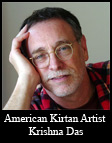| Free Jyotish Newsletter |
 Jyotish.ws
Jyotish.wsKirtan Chanting in America: Westerners Taking "A Chants"
 By Andrea Pflaumer
By Andrea Pflaumer
In the not-so-distant past, before Homeland Security measures rendered airport lobbies off-limits, the only "orange alerts" to which weary travelers were subjected were gatherings of young people in saffron robes handing out tracts and chanting the names of Hindu deities: "Hare Krishna, Hare Krishna, Krishna Krishna, Hare Hare." Back in the 1970's, the eponymously named Hare Krishnas raised ecstatic voices and "kundalinis" with their intoxicating drumbeats, encouraging all within earshot to turn their minds to God. What they were performing was an ancient devotional practice from India called "kirtan"—literally "to praise that which is exalted"—and its legions of practitioners have recently surged.
The practice of kirtan can be as simple as the call-and-response repetition of the name of an archetypal Indian deity or recitation of a devotional Sanskrit phrase honoring the deity. It is different from the popular "bhajans," (devotional lyrical songs based on scriptural texts and classical music of India) although some American kirtan "wallahs" have been known to perform both, blurring the distinction. For beginners as well as hard-core fans, kirtan's appeal can be deeply emotional. The effect is likely due to kirtan's association with the branch of yoga called bhakti: devotion and surrender. The fact that most of the chants are sung in Sanskrit adds another dimension of accessibility. "The Sanskrit language was designed to allow you to have a spiritual opening and a connection," explains Clark Samson, a plumbing contractor in California and kirtan fan who first learned about the practice by listening to a friend's CDs featuring American kirtan artist Krishna Das. Krishna Das is one of the world's best-known kirtan wallahs.
In spite of the echoes of Indian culture, it is has become popularized world-wide, excluding no tradition or religion. Jai Uttal, another well-known American chant artist, explains, "Kirtan is designed to heal the heart. When the heart is in the process of healing, it naturally becomes connected with universal spirit, however we look at it." Most of kirtan's champions in the US came to the practice by way of the Indian saint, Neem Karoli Baba. In 1970 Krishna Das turned down an offer to be the lead singer for the rock band Blue Oyster Cult shortly after Ram Das introduced him to Maharaj-ji, as Baba was known. Though the guru did not teach a formal practice, his charge was simple: "Meditate like Christ." When asked what that was, he replied, emotionally, "He lost himself in love." Maharaji also encouraged a channel for devotional practice that resonated with his musical devotees: "go and sing."
During its infancy in the US, kirtan was simply one of several items on a menu of practices offered at ashrams or spiritual retreat centers. Over the past twenty years, kirtan has ventured into the secular world, becoming a popular public event at yoga studios, which are a ready-made circuit for touring kirtan artists. As a result, the practice began attracting audiences looking for a spiritual experience as well as an artistic one. The most recent expansion of interest in chanting is largely due to a number of western musicians who have molded the form to their own artistic leanings and spiritual insights.
Although many American kirtan wallahs come with lengthy credentials from the rock, jazz and traditional music worlds, what sets their chanting events apart from other music concerts is the uncharacteristic humility one senses from the performers. There is also a relative lack of idol worship of these artists, even by die-hard fans. Those phenomena are due in part to the requisite audience participation. Another significant factor is that for many Western kirtan performers, chanting is the very public expression of their very private spiritual practice. Today, kirtan events can be found on every continent, performed by artists and chanters embracing almost every musical style imaginable, from blues and Celtic, to Latin and jazz.
(c) copyright 2007 Michael Laughrin.
From the December 2007 / January 2008 issue of Michael Laughrin's North American Jyotish Newsletter. Click to subscribe to this free Jyotish newsletter.
Read more articles.
Yagyas offered by Michael Laughrin.
Learn about Michael Laughrin's credentials.